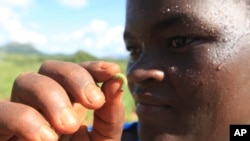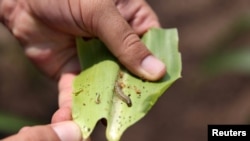A recently arrived species of armyworm has spread to 21 African countries and threatens the continent's main food staple, maize, report experts from the U.S. Agency for International Development.
USAID senior biotechnology advisor Joseph Huesing says the fall armyworms -- transported from their usual habitat in the U.S. state of Florida or the Caribbean -- are attacking maize crops all over sub-Saharan Africa.
"From Nigeria and Ghana all the way to South Africa to Ethiopia. The most recent one is South Sudan, which reported fall armyworm infestation toward the end of June," Huesing tells VOA's Horn of Africa service.
Fall armyworms pose a big threat to the continent's agriculture, says Huesing. When they invade a maize field, he says, the pests can eat 30 percent or more of the crop.
They consume other crops too. “We assume that anywhere there is a green plant or maize in Africa, fall armyworms will show up in a short period of time," Huesing says.
Challenge to Control
Fall armyworms got their name from the time of year when they do the most damage in the northern part of the United States. The first publication describing their presence in Africa came out in early 2016, which suggests the pests had already been there for a year.
For several reasons, the fall armyworms may pose more problems for farmers than the indigenous African armyworm.
Fall armyworms can breed continuously under warm and humid tropical conditions and can feed off more than more than 80 species in 27 plant families, says Yene Belayneh, senior technical advisor for pests and pesticides at the USAID.
When they assume their adult form as a moth, fall armyworms can fly up to 100 kilometers per day if pushed by winds, or much longer if the pests hitch a ride on a jet.
“If there is an outbreak for example in Ethiopia, alerting Sudan or Eritrea would be a wise thing,” he says.
In fact, there is an outbreak in Ethiopia. The country's Plant Protection Directorate said that as of July 10, fall armyworms have infested more than 440,000 hectares of crops. It said that about 305,000 hectares had been protected, either through "cultural means," such as picking up the pests by hand and crushing them, or chemical spraying.
Harder to detect
But spraying may be less effective with the new invaders than with indigenous armyworms. The fall armyworm "penetrates the plant and feeds from inside," says Belayneh, making it harder to detect and harder to kill.
The species is vulnerable to freezing temperatures, but those happen rarely if ever in much of Africa.
Regina Eddy heads the USAID's armyworm response team. She says her department’s priority is to provide training and technical options, taking Brazil as a model. Brazil spends an estimated $600 million per year to control armyworms, according to a recent USAID report.
One control measure experts are taking is to more carefully inspect food arriving at African airports. The fall armyworms may have arrived on the continent through a food shipment from abroad.
Eddy says the fall armyworm is not causing a crisis yet. “For now the infestation is relatively at an early point, and we haven’t seen widespread food insecurity as a result of crop loss from the fall armyworms, and experts are on the fields assessing,” she says.
But Belayneh says no one is taking the situation lightly. Africans are used to coping with the native armyworms, he says, “whereas with this new species, everybody is trying to find out the best options to prevent, control and manage."






